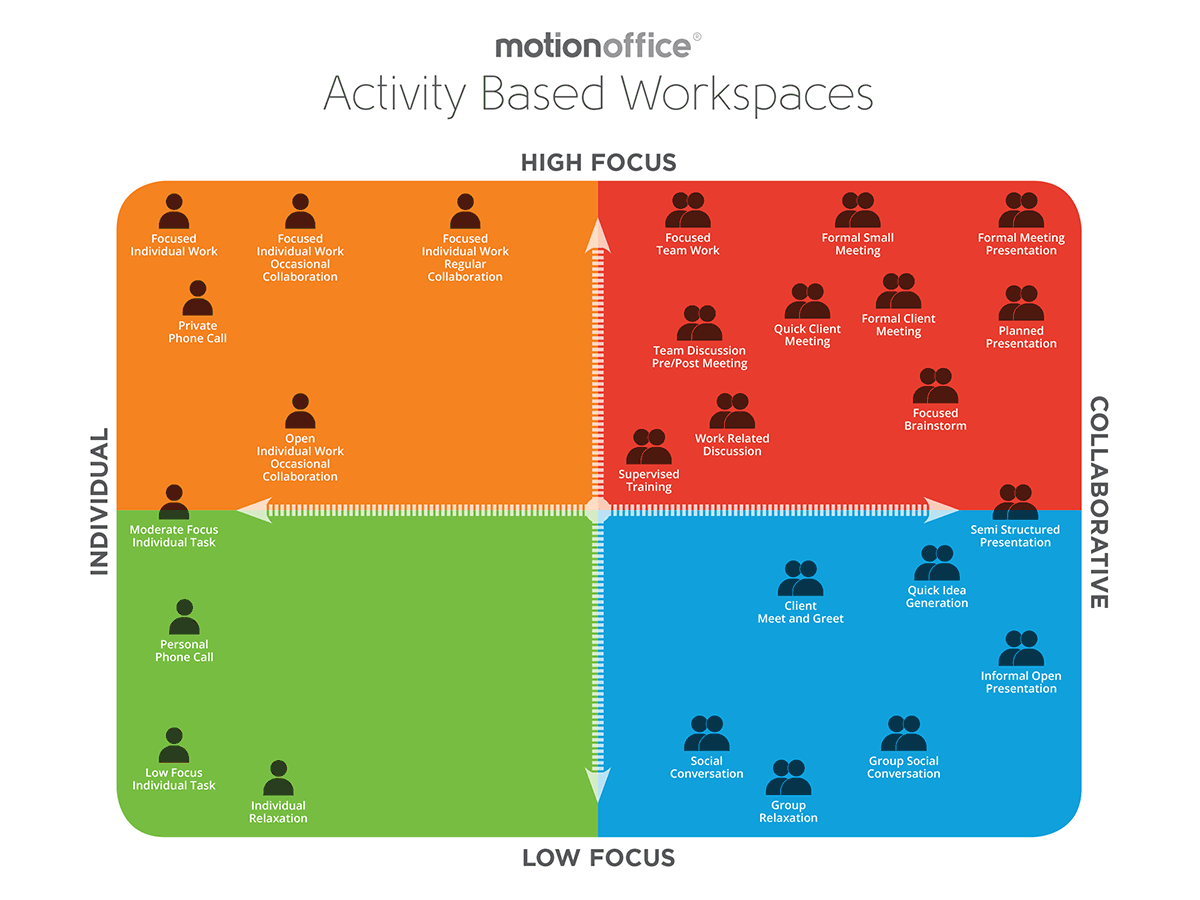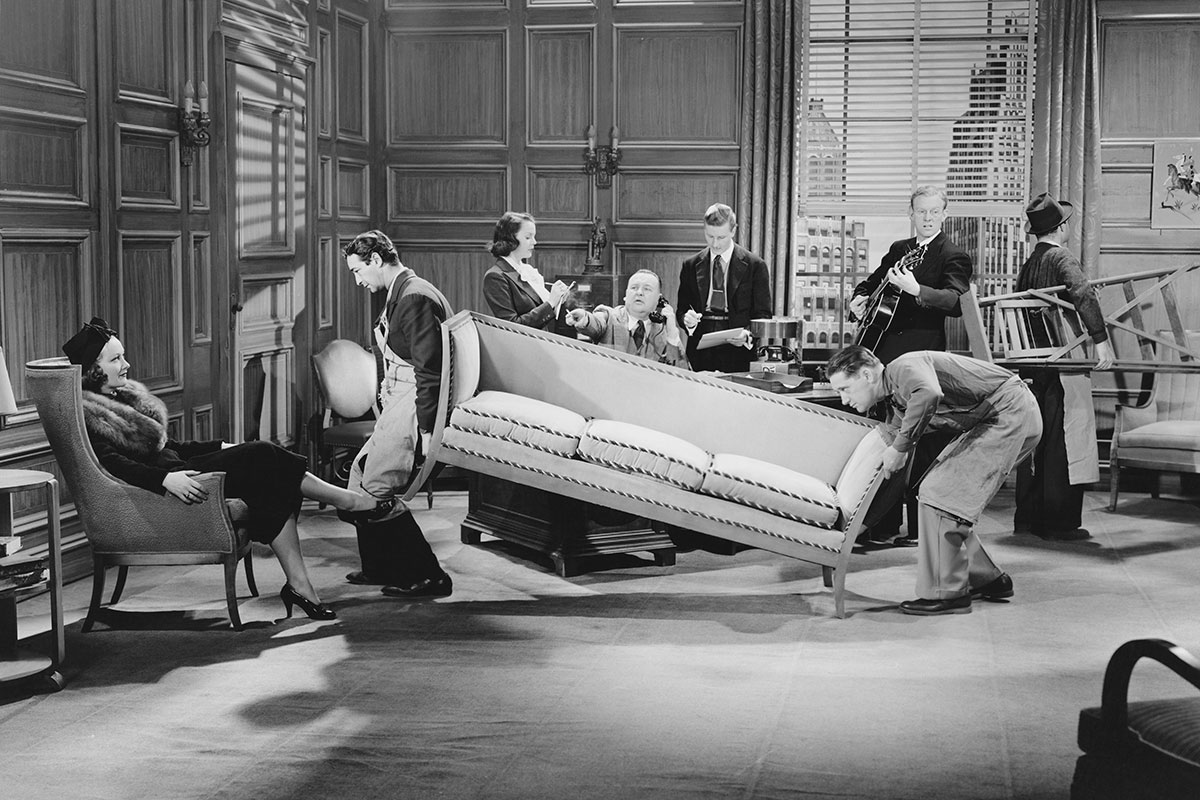- Home
- →
- Agile Working
While it is true that many businesses do not have any plans to move to an ABW situation, large numbers of companies are planning to do so or have already placed their business in this situation. Many are already using their own ABW operation. So if you are considering a move to Activity Based Working, there are a number of important points you should consider before you start the move.
Involve your employees in the project
One of the best benefits of operating under an ABW system is the improved working lifestyle it provides for your staff members. So that means it is all the more reason why they, your workers, need to be involved in initial discussions, planning and implementation of your new flexible workplace operating system. No matter how highly you think of the ABW situation, it's essential that your fellow workers feel as much a part of the change as does the management. Get everyone involved and from the very beginning.
Make sure you have the technology to support the move
A major shift in the layout and structure of your business premises is likely to provide serious benefits to your operation and productivity. But a better layout of your workplace will lose the value of such benefits unless you have the technology to match. Great flexibility in moving around is useless unless the equipment - hardware and software - supports the new freedom. This is one aspect of pre-planning which you cannot avoid. Do you have the technology at present to support, to lead and to work with the changes you plan once you implement your ABW system?
Make a case for the change before you start
Despite the fact that thousands of businesses have already implemented their ABW system and done so with great success, it's vitally important that you make the case for how the change will work in your situation. Your business is unique. You have your own needs and goals and work pressures and in order to successfully implement ABW, you need to know precisely how it will benefit your operation. It is most definitely not a case of one size fits all. You require a specific design to get the maximum benefit. The principles of ABW are universal but the application is specific to each individual business. Do a business plan as you would for any new start-up. Do not consider buying a design off the rack but rather seek a bespoke system specific to you, your workers and your business
Know your business inside out
If you have been operating the way you are for many years, it's possible, even likely, that you have become set in some of your ways. To ensure that the implementation of ABW in your workplace goes successfully, you need to be sure of your goals and methods of operation. It's almost as if you are going back to the reason why the business was started in the first place. Don't take anything for granted and treat the situation as if you were starting afresh.
Consider all possible options
There are many experts who can assist with the implementation of your ABW setup. Just as every business varies, so too will the options provided by different designers. Take your time in selecting a designer and take your time in selecting the design they suggest. It's very much a horses for courses situation. You need the right design for the right business. By all means look around, talk to others who have adopted their own ABW plan and choose what's right for you.
Just because the concept of activity based working is believed to be outstanding, it doesn't necessarily mean it is right for you. Or, if it is right for you, you may not be in an ideal position to implement such a flexible working environment. So how do you know the optimum time for adopting this type of physical and cultural change? There are several points you should consider. You would do well to let each point help you make the right decision.
Getting the best talent
If your industry is highly competitive and you need outstanding new talent, you stand a much better chance of attracting these top workers if you have ABW in operation. The quality employees are more likely to favour a business which is a leader in the field as demonstrated by your work environment. A poorly designed office space is counter-productive. It frustrates workers and drives away top talent. You need to take advantage of a flexible working space and become a leader in your field.Where are your staff members located?
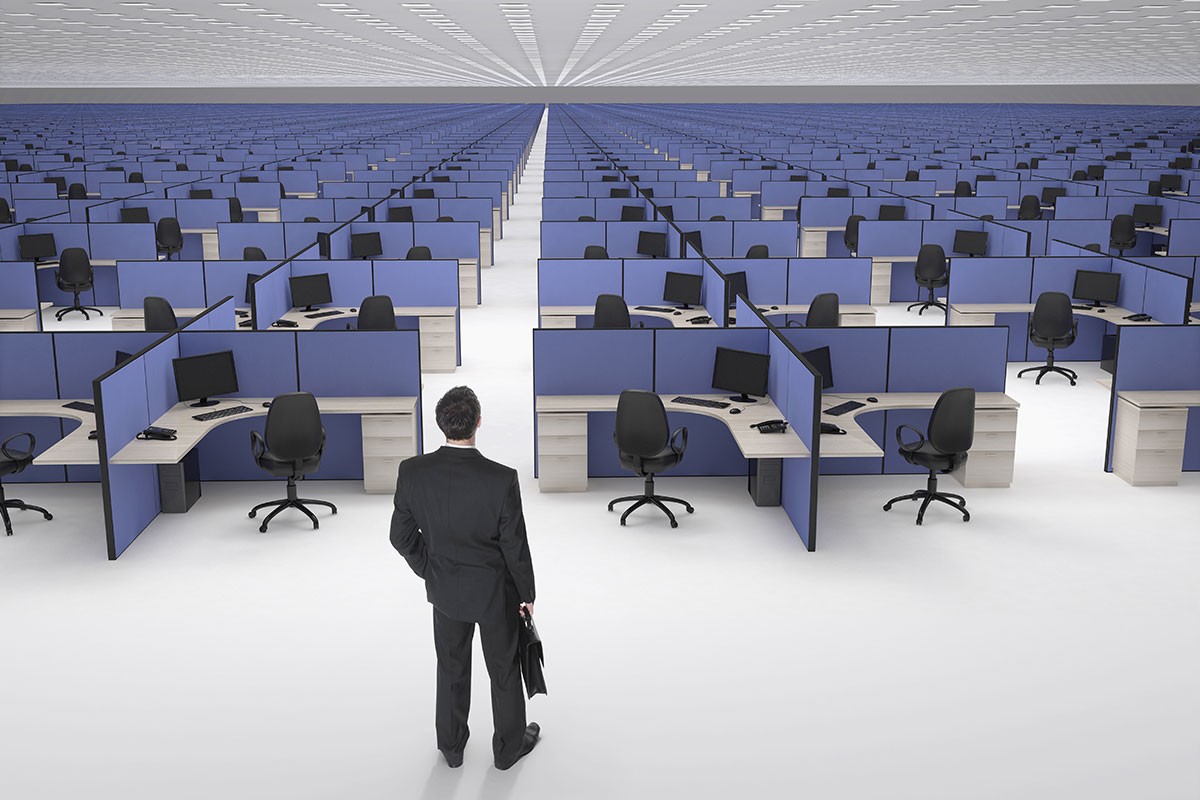
Are you moving?
If, for whatever reason, you are about to shift location, then starting afresh with an activity based working plan is ideal. You are starting from scratch. Start the planning before you move. Take advantage of this new start and have the new flexible working arrangement in place on day one.You need to grow but not expand
If you find your business is in need of more employees but because of the cost of real estate you are not able to expand your physical premises, then now is a good time to introduce a more flexible working environment. By doing so you can engage more workers and have them operate more successfully but in the same space. You can have greater staff numbers but in the same but better space.Employees are free to work at home
Many businesses today allow members of staff to spend at least some of their working time at home. Technology enables this to happen. Are you in that situation? If so, then that means some of the desks in your office are not needed at all or as often. If that's your business then you are in a good position to consider a change in your physical layout.Are you getting the best out of your workforce?
This is a major issue. Productivity is always a key element in the success of your business. Investing in the latest technology and the brightest people are basic principles that any successful business will follow. But that does not mean that your workforce is operating at its full capacity. It might be that your employees are being hampered by the setup and layout of your office. If so, then you are in an ideal position to make a change to a more flexible working environment.Workspace boosts creativity
It's a simple case of a flexible working environment bringing creative people together in more effective ways. Ideas can make your fortune. Helping your employees discover, develop and implement these ideas is strictly related to how well they mix and co-operate in their work space. Fix that and the creativity flows.There are many valuable benefits when adopting an ABW plan which is why it is so popular. What is really important though is to understand why it is so good and what it actually is. Let's start with what it's not.
Some people who work in an open-plan office think they are in an activity based working environment. They are not. An open plan office is just a traditional office layout with fewer walls and pieces of furniture. An ABW workspace creates areas to maximise cooperation between workers and thus the overall productivity of the business. It is a flexible working environment.
In an ABW set-up you might have team desks, conference spaces, phone areas, quiet rooms, brainstorming areas, a lounge and working areas. There could be seated or standing work areas. Each design is unique to the business in question. And it is because the ABW design is so radically different to other officer layouts and designs which make it so popular.
So why has this new style of operation become so popular?
Productivity increases
Every business requires and desires better productivity. One of the primary benefits of an ABW setup is the boost it gives to productivity. Popularity of the new layout is guaranteed when productivity improves. It's a win-win situation for workers and the business.
Collaboration increases

Having your workers work better with one another is a huge benefit. Better communication, exchange of skills and new ideas eventuate. Collaboration is vital to the success of your operation. Positive and constant collaboration is the best of both worlds. Your workers collaborate far better in a specific work space using an ABW model.
You better understand your role
Just what is your role at work? Confusion as to your responsibility and your tasks makes for an underperforming worker. That makes them unhappy, unproductive and the consequence is that the business suffers as a result. If that lack of productivity spreads throughout the company, results will be poor even disastrous. With a clearly defined ABW setup, people know their role and are far better able to perform it and well.
You concentrate better
The work environment is so crucial to the ability of the workforce to concentrate; the better their concentration powers, the more productive the worker. If workers are 'locked' into their area with limits as to where they can go and with whom they can collaborate, the worker drifts in their thinking. It's easy to lose concentration. Having workers move freely within the space and mingle in a structured way gives them new energy and aids their ability to concentrate. No wonder an ABW setup is so popular.
You remove sedentary lifestyle at work
The mental and physical wellbeing of your workers is a key to the success of your business. Having people sitting for long periods in their own little world is not good for their health and not good for business. All the well-designed furniture in the world is not the total answer. People may often be happier and more productive standing than sitting. That's the beauty of an ABW approach. It is flexible and is designed to suit your specific needs. You can improve the health of your workforce by changing their environment. And let's face it; a healthy workforce is by far the better option.
Work becomes more enjoyable
A happy workforce is always welcomed by management. If your workers are keen to come to work and find being at work a fun or enjoyable and challenging experience, you are running a business which is far more likely to succeed than if your employees are decidedly unhappy. An ABW design is popular because it makes the workers happy.
I recently had a conversation with one of my neighbours who opened my eyes to the benefits of homeschooling. Like other people, I've always had my doubts that homeschooling could possibly offer the same quality of education as a traditional school setting. But the very things I thought didn't work about it are actually what make homeschooling work so well, according to my neighbour, who homeschools her three small children.
For instance, I always thought customising an education would somehow not prepare a child for the "real" world. But my neighbour made me understand that the best education is one that is tailored to each specific child and considers their learning preferences and needs. In her estimation, if the end goal is preparation for adulthood, the simplest means to get there is a curriculum that allows room for creativity and flexibility.
What she said made a lot of sense and it got me to thinking. Perhaps so many people believe that activity based working (ABW) doesn't work because they don't completely understand the benefits, or at least, aren't looking at the benefits as benefits. If the end goal of any business is happier and healthier employees who are more productive, then certainly the claim that activity based working doesn't work is a false one.
Why Fostering a Variety of Office Environments Does Work
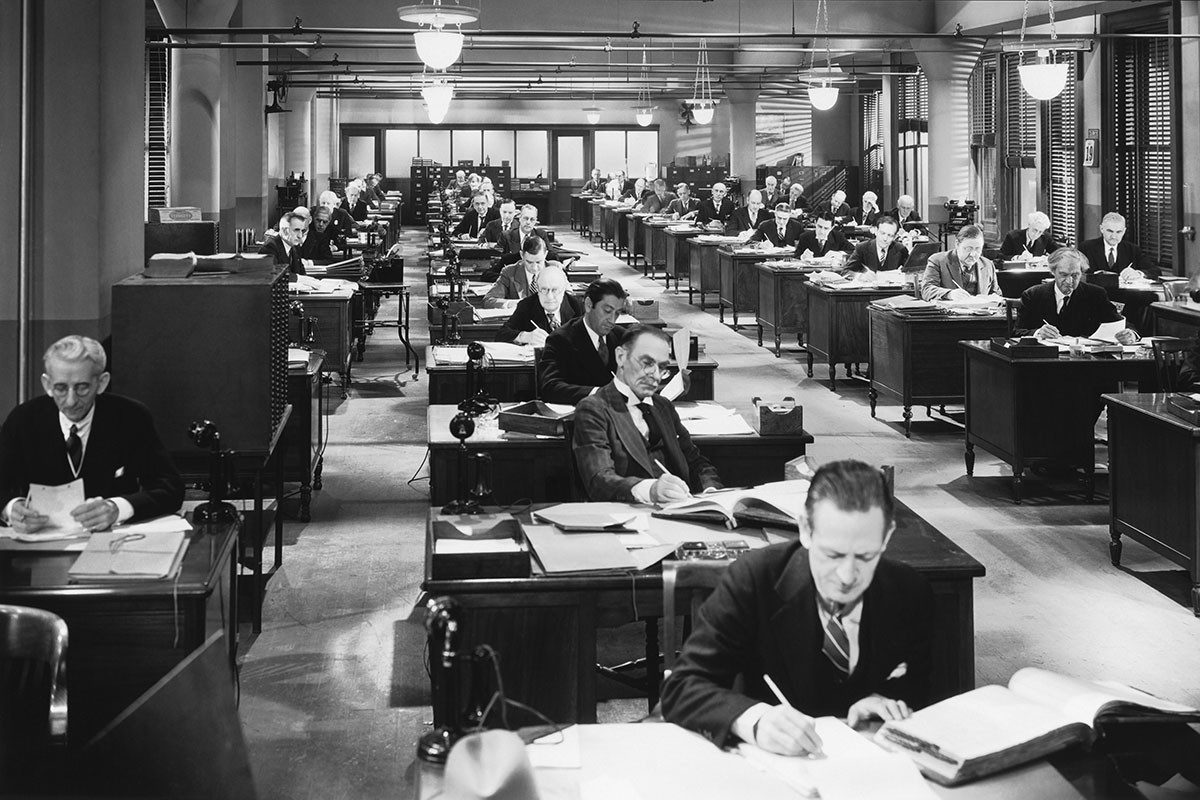
Decades ago, when traditional office spaces were created, they were done so with no more in mind than to make sure every worker had a place to work. An employee showed up, "clocked in," sat down at their desk and began tackling their daily activities. Little thought was given as to whether or not the day's activities could be performed optimally in that traditional environment.
This is exactly why ABW does work, and why the concept of designing a space that supports optimal work makes a lot of sense. In any given day an employee will have certain tasks that require them to think creatively. Other tasks will require collaboration with team members, and still others will simply require the ability to focus on the mundane chores at hand. In an ABW space, people choose which office environment will best support the task at hand. This is no different, really, from a chef choosing the right knife or a carpenter choosing the right tool for a specific task.
Clearing Up Some Myths
The myth that activity based working doesn't work is most likely based on a variety of other myths, such as:
Hybrid offices don't exist.
One of the biggest myths floating around is that ABW spaces don't allow for any assigned desks. Many believe if they were to walk into an ABW setting they would see a bunch of people milling about with no real place to land. But that's simply not the case.
The truth is, most ABW offices take a hybrid approach, offering individuals both assigned and unassigned work spaces. Since not everyone requires an assigned desk, a hybrid approach makes the most sense.
ABW automatically means one, big open space.
Beyond the belief that ABW means no assigned desks, many people also believe that an ABW office is just one big, open space with bad acoustics and no real privacy. While these spaces do exist, they are not the fault of ABW but of poor budgeting and even poorer design.
Rest assured that a well-designed open plan with a variety of work settings can and does work.
Eventually, all employees work from home.
I'm not sure how this myth came about, but there seem to be many who believe that an ABW environment puts you one step closer to an entirely remote staff. That's like saying adding a new deck onto a house is the catalyst to eventually living in a yurt. While many employees could perform some of their duties away from a traditional office space, it is not a mandatory component of ABW. In fact, ABW is about designing a space people WANT to be in, not away from.
ABW is all about design.
This is another big myth, and perhaps one of the most damaging. Much focus is given to the design aspect of ABW, and in reality, that's the wrong place to put the majority of the focus. And we're designers saying that!
The truth is, ABW is as much about an organisation's culture – both its current culture and the one it hopes to foster – as it is about thoughtful design.
The Many Benefits of ABW
Now that we've debunked some of the most common myths surrounding ABW, it's time to talk about its biggest benefits.
Savings
ABW helps businesses save money in a few different areas:
- Reduces services charges
- A Smaller property footprint
- Decreases rental lease
- Lower energy bill
- Lower maintenance costs
- Less costs for office supplies (fewer printers and paper, for example)
Interpolis, a Dutch insurance company, reported a 45% reduction in necessary work space and a 24% reduction in yearly occupancy costs.
Improved collaboration
In a traditional office environment, with employees chained to their desks, collaboration and communication is hindered. Let's say Frank, Jane and Robert need to have a pow-wow about an upcoming presentation they're giving, but the conference room is already taken. What do they do, all crowd into Jane's tiny cubicle?
ABW allows team members to freely move around the space and find a setting that will allow them to easily collaborate on important tasks.

Better focus and concentration
ABW provides a range of work settings designed for specific tasks, like quiet work where much focus is needed.
Improved recruitment and retention
One of the best ways to attract new talent is to offer flexible and creative ways of working. One of the best ways to keep existing staff happy is to offer the same thing. When the workplace is dynamic and engaging and meets everyone's needs, people are simply happier working there.
Increased innovation
You know what breeds the most innovation? The kind of space where staff can have whatever they need whenever they need it. Provide your team with flexible and creative work spaces and watch their creativity and imagination grow.
Activity Based Working Works with the Right Components in Place
Despite the fact ABW is highly-effective and beneficial, it is not guaranteed to work. As with anything in life, proper alignment and support have a lot to do with successful implementations of any change. Does ABW work? Without question. But there are some components that need to be in place.
Put culture before design.
Too many companies fail with ABW because they have focused heavily on the logistical and physical changes to the space and given little thought to the cultural changes of the organization. In order to be successful, you must first think about how this change will affect your culture.
Managing cultural change is no small or easy task, but it is a necessary one. Here are some things to keep in mind:
- Get senior management involved – Your organization's leaders need to be involved and champion the change.
- Communicate your vision clearly – Don't simply announce on a Monday that you're going to change to an ABW office setting and then stop all communication. You need to communicate your vision as well as progress on a regular basis. Keeping silent can be even more stressful than the change itself. And remember, communication is a two-way street, so listen to your employees and field any questions they may have.
- Provide support throughout the change process – Everyone will respond differently to the change in their working environment. Some may adopt it easily and happily, while others may feel overwhelmed and nervous. Be sure to lend support to make staff as comfortable as possible.
Good design starts with a clear vision.
You'll definitely need a clear vision of your desired outcome in order to create the right design. What are you trying to achieve in your environment? Does your business require more and better collaboration, or more solo spaces for quiet, contemplative work?
When working with your designers, we suggest you conduct an audit to see how your current space is being used. The information gathered during this process will help you establish a realistic ratio of employees per seat.
Also, be sure to get your staff involved in the designing process. This will not only result in greater satisfaction with the end product, but also promote a sense of ownership and buy-in.
Have the right team in place to drive change.
Be sure to have a multidisciplinary team of employees in place that has the authority to make major decisions in the areas of change management, communication and design. Just as important is to ensure this team truly represents your workforce and can be effective ambassadors of change on your behalf.
Today's organisations and designers share a vision to make employees lives in the workplace more inspiring and joyful. ABW works toward this end, and companies who wish to improve the health, happiness and productivity of their staff should consider making the change.
Mobile devices have freed office workers from being desk bound and led to a new way of working: Activity Based Working or ABW. As more and more companies make the shift to ABW workspaces, the evidence is clear that a more flexible style of working benefits both employees and employers, saving time and increasing productivity. Now, with the comprehensive MotionOffice range of furnishings, implementing ABW is easier and more affordable.
A global survey of over 12,000 office workers in 17 countries was released recently by global office furniture giant Steelcase. Designed to measure the connection between employee engagement and workplace satisfaction, the survey results revealed the sad fact that 11 per cent of employees were highly dissatisfied with their offices and also highly disengaged (ie bored, unhappy and possibly even severely depressed).
On the other hand, just 13 per cent of global workers reported being highly satisfied with their workplace and highly engaged (ie happy, thriving and loving their jobs).
The importance of control over where and how we work

What is the key factor linking all these happy, thriving workers? They reported having a greater degree of control over where and how they work, including access to privacy when they need it. According to the report, Engagement and the Global Workplace, "They are empowered, both by organisational decisions and the spaces made available to them within their workplace, to make choices about where and how they work. This means they can manage their need for privacy so they can concentrate easily and work with teams without disruption.
"This finding suggests that a key design principle for the workplace is to create a range of spaces – for groups and individuals, mobile and resident workers – and corresponding work policies that enable employees to make choices about the best way to work."
In other words, the happy, thriving, productive workers were empowered by a concept in workplace design known as Activity Based Working (ABW).
A place for every task
ABW was enabled by the rise of mobile devices. With no need to sit at one desk all day in front of a fixed PC, new ways of working were suddenly possible. Office workers could be freed from their private cubicles and corner offices to work across the office in different zones designed for focussed work, collaborative work, presentations and training and casual interaction.
The concept of ABW was first developed and made widespread by Dutch consulting firm Veldhoen + Company. The first ABW workspace, in 1997, was the head office of Interpolis, a Dutch insurance company.
The concept was quickly adopted by the financial sector, followed by businesses in the property sector. Today, many professional services, communications and technology companies, even legal firms are developing, testing or have already implemented versions of ABW.
ABW is constantly evolving as new technologies and work practices emerge, leaders learn from one another, and companies continue to shape the core concept to their own specific needs and company culture.
Working smarter, not harder
Canberra-based time-management consultant Johanna Jansen may well be the woman with the lowest chaos and stress tolerance you'll ever come across. Every day, she wakes up to make her life a little less complicated than it was yesterday. Johanna values space over stuff. She creates time to do nothing. She has a handful of lists so there is nothing on her mind. Her inbox is zero once daily.
In her blog, Time Mine, Jansen shares her ideas about time and work and how to work smarter, not harder. Unsurprisingly, she is a strong advocate for Activity Based Working.
As Johanna explains, "Activity Based Working is a concept to design your office in such a way that it supports work activities optimally, rather than drawing a boundary around its users' personal spaces. In practice, it means that an ABW space fosters a variety of office environments, that are all supporting different activities, performed by its residents in their work.
"In an average ABW office, that would be a mix of team desks, quiet concentration rooms, telephone booths and a meeting room. More advanced ABW offices may also offer stand up meeting tables, a brainstorm area, multimedia rooms, a lounge area and stand up working stations. All ABW spaces should have a fast wireless network. In all, facilities are shared between coworkers and management, no one has their own desk, except maybe security staff."
Each day is filled with many tasks we each need to do, but the attention required for each task is not uniform. Some tasks require us to think creatively, for others we need to collaborate, and others are simply mundane daily chores. In an ABW workspace, each person can choose a desk, room or area according to the task at hand.
A well-designed ABW workspace is designed to support each individual in doing their particular tasks.
How Activity Based Working benefits employees
With Activity Based Working you:
- Concentrate better
- Are more productive
- Are more active and less sedentary during the work day, allowing higher energy levels
- Are more likely to collaborate and share ideas and skills with others
- Are more mindful of your tasks, activities and productivity
- Enjoy working more
"In a more traditional office you're always distracted at least a bit all the things you could do at your desk," says Jansen. "So you cannot focus fully on a single task. And people are most productive when they are focussed on a single or support task. By working activity based, you condition your mind and body to get the most out of time and space and, the good thing is, you get better at it every day.
"Start to think about your tasks in terms of 'How can I best perform this task?' and 'What environment that I have access to best supports me in doing that?' You can choose to sit in a quiet library doing concentration work, or invite others for a coffee and a chat about your project in a nearby cafe, make your phone calls standing up (you'll make them briefer) or organise a stand up meeting."
Ultimately, if you are able to choose the space that best suits the project at hand, you are also more likely to complete it more quickly. In other words, you can work less and achieve more.
Rethinking the workspace
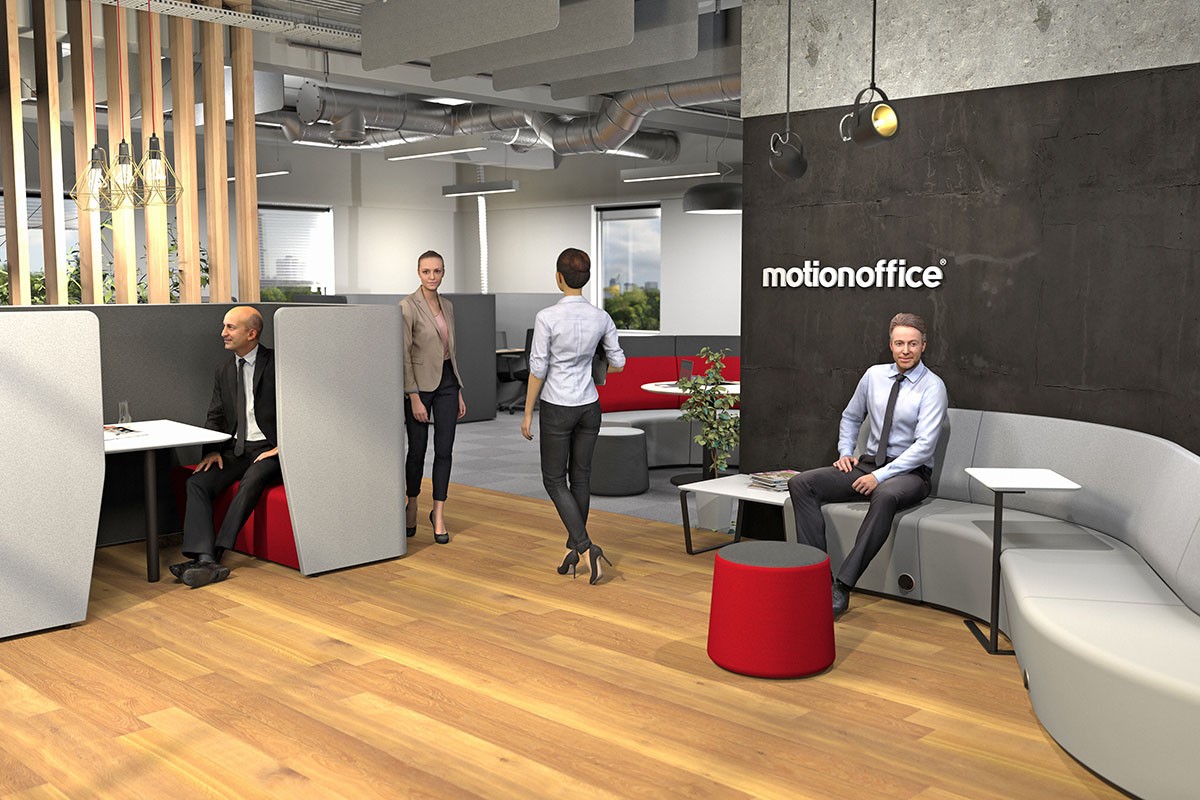
Implementing ABW in the workspace, however, requires a complete rethink and specialised flexible furnishings designed specifically for ABW applications. This is where MotionOffice comes in – a comprehensive range of well-designed and attractive office furnishings specifically designed to easily and affordably create personalised arrangements for an individual company's specific needs, according to the tasks their employees need to undertake on a daily basis.
In her book, Create a Thriving Workspace, Melbourne-based workplace design specialist Anetta Pizag, says that the best Activity Based Workplaces are dynamic environments geared towards teamwork, with collaborative spaces taking up over 30 per cent of the floor area (while in traditional offices this is typically around 10 per cent).
"This is achieved within the same, or smaller, floor spaces since with non-assigned seating the space is used more efficiently," says Pizag. "Activity based workspaces typically offer five to 10 different types of work settings for individual as well as team activities. These spaces are designed to help people excel in each activity, whether it's generating ideas, solving problems, executing plans or sharing knowledge.
"ABW is a potent strategy. If implemented well, the benefits are enormous. It creates a less hierarchical workplace that stimulates interaction and knowledge exchange, supports learning and professional development, promotes trust and personal accountability, and makes work more efficient as well as more enjoyable."
Selecting the right furniture is essential
UK office design firm Morgan Lovell advises that "furniture plays a huge role in Activity Based Working. So it's important you give staff spaces that help them work flexibly". In its Activity Based Working Checklist, Morgan Lovell advises:
- Make sure the desks and chairs are robust as they will be well used.
- Think about the type of soft seating needed that will encourage people to sit down and work together. Meeting tables with an integrated screen are great when small groups need to collaborate but don't want the formality of a large meeting room.
- Think about different solutions to create privacy, such as high-backed sofas that create a private meeting space without the need for a separate room.
- Think about movable furniture that meets different needs, such as for small meetings, phone calls or casual conversations.
- Select furniture with integrated power. As people will be wandering around with laptops and other mobile devices, provide plenty of sockets so they can power up.
- Tables to spread out papers are often overlooked, but very popular with staff.
All this and more is incorporated in the MobileOffice range, with an important added benefit. The major complaint for office workers in open plan offices is distraction from noise. MobileOffice acoustic panels are Acoustic Certification Tested to absorb 76 per cent of sound waves, dramatically reducing 'noise bleed' in open plan environments.
So with ABW and MotionOffice it is indeed possible to work less and achieve more, with a greater degree of work satisfaction in the process.


